Electromagnetic Characteristics Analysis of Quadrupole Compound Orbital Electromagnetic Launcher with Different Configurations
Abstract
:1. Introduction
2. Physical Model and Simulation Conditions
2.1. Physical Model
2.2. Simulation Conditions
3. Simulation Analysis
3.1. Analysis of Electromagnetic Characteristics of Different Configurations
3.2. Influence of Concave (Convex) Value on Electromagnetic Properties
4. Conclusions
- (1)
- On the contact surface of the armature and the rail, the maximum current density of concave elliptical armature is 6.4 times and 2.8 times that of the flat armature and the convex elliptical armature, respectively, and the maximum current density of the flat armature is the smallest, which shows that the flat armature can effectively reduce the maximum current density and mitigate thermal damage.
- (2)
- Among the three configurations, the maximum magnetic field strength at the front and rear end surfaces of the concave elliptical armature is larger, but the concave elliptical rail produces the largest electromagnetic thrust and the smallest radial electromagnetic force. Moreover, the armature is more stable in the firing process with the highest energy utilization.
- (3)
- The maximum current density on the contact surface of the armature and the rail and the magnetic field strength at the front and rear end surfaces of the armature are negatively correlated with w. As w changes from 1 to 3, the maximum current density of the convex elliptical rail decreases on the contact surface of the armature and the rail, and the concave elliptical rail decreases. The electromagnetic thrust on the concave elliptical armature is negatively related to w, while the electromagnetic force on the convex elliptical armature is positively related to w.
Author Contributions
Funding
Institutional Review Board Statement
Informed Consent Statement
Data Availability Statement
Acknowledgments
Conflicts of Interest
References
- Lu, J.Y.; Feng, J.H.; Li, K.; Li, X.P. Review of research on ultra-high-speed guided projectiles. J. Harbin Eng. Univ. 2021, 4, 1–12. [Google Scholar]
- Wang, Y. On electromagnetic launcher to open the era of electromagnetic weapons. Electr. Technol. 2010, (S1), 1–4. [Google Scholar]
- Ma, W.M.; Lu, J.Y.; Li, X.P. Electromagnetically launched hypervelocity integrated projectile. J. Natl. Univ. Def. Technol. 2019, 41, 1–10. [Google Scholar]
- Li, T.D.; Feng, G.; Liu, S.W. Analysis of electromagnetic characteristics of the proposed composite four-rail electromagnetic launcher. Sci. Eng. Compos. Mater. 2022, 29, 113–125. [Google Scholar]
- Li, T.D.; Feng, G.; Liu, S.W.; Shi, J.M.; Fan, C.L. Simulation and Analysis of Electromagnetic Characteristics of Copper-based Composite Quadrupole Rail. Syst. Eng. Electron. Technol. 2021, 43, 3054–3063. [Google Scholar]
- Coburn, W.O.; Le, C.; DeTroye, D.J.; Blair, G.E.; Williams, W. Electromagnetic field measurements near a railgun. IEEE Trans. Magn. 1995, 31, 698–703. [Google Scholar] [CrossRef]
- Wang, G.H.; Xie, L.; Zhao, H.L.; Kan, M.X.; Xiao, B.; He, Y.; Song, S.Y. Simulation analysis of electromagnetic field evolution during launch of tandem-enhanced railgun based on moving window. Explos. Shock. 2021, 41, 111–118. [Google Scholar]
- Zhang, H.H.; Li, S.; Gao, X.; Lu, T.; Liu, F. Distribution Characteristics of Electromagnetic Field and Temperature Field of Different Caliber Electromagnetic Railguns. IEEE Trans. Plasma Sci. 2020, 48, 4342–4349. [Google Scholar] [CrossRef]
- Ruan, J.H.; Chen, L.X.; Xia, S.G.; Wang, Z.J.; Li, L.D. Review of current distribution characteristics of electromagnetic railguns. J. Electrotech. Technol. 2020, 35, 4423–4431. [Google Scholar]
- Liu, M.; Tao, S.; Xue, X.P. New Quadrupole Orbital Electromagnetic Launcher. Firepower Command Control 2019, 44, 23–27. [Google Scholar]
- Li, T.D.; Feng, G.; Liu, S.W.; Ren, S.D.; Fan, C.L. Static analysis of armature and rail with different configurations of four-rail electromagnetic launcher. J. Ballist. 2021, 33, 90–96. [Google Scholar]
- Li, T.D.; Feng, G.; Liu, S.W.; Ren, S.D.; Fan, C.L. Influence of orbital configuration of four-rail electromagnetic launcher on current distribution. Weapon Mater. Sci. Eng. 2021, 44, 5–11. [Google Scholar]
- Xie, H.; Yang, H.; Yu, J.; Gao, M.Y.; Shou, J.D.; Fang, Y.T.; Liu, J.B.; Wang, H.T. Research progress on advanced rail materials for electromagnetic railgun technology. Def. Technol. 2021, 17, 429–439. [Google Scholar] [CrossRef]
- Mao, B.Q.; Zhang, T.Y.; Bai, X.H.; Zhu, R. Design of anti-ablation armature structure for electromagnetic rail gun. J. Ordnance Equip. Eng. 2020, 41, 67–71. [Google Scholar]
- Praneeth, S.R.N.; Singh, B.; Khatait, J.P. Study on effect of rail filet radius in electromagnetic railgun. IEEE Trans. Plasma Sci. 2021, 49, 2997–3002. [Google Scholar] [CrossRef]
- Hsieh, K.T.; Satapathy, S.; Hsieh, M.T. Effects of pressure-dependent contact resistivity on contact interfacial conditions. IEEE Trans. Magn. 2009, 45, 313–318. [Google Scholar] [CrossRef]
- Lydia, J.; Karpagam, R.; Murugan, R. A Novel Technique for Dynamic Analysis of an Electromagnetic Rail Launcher using FEM Coupled with Simplorer. Appl. Comput. Electromagn. Soc. J. (ACES) 2022, 37, 229–237. [Google Scholar] [CrossRef]
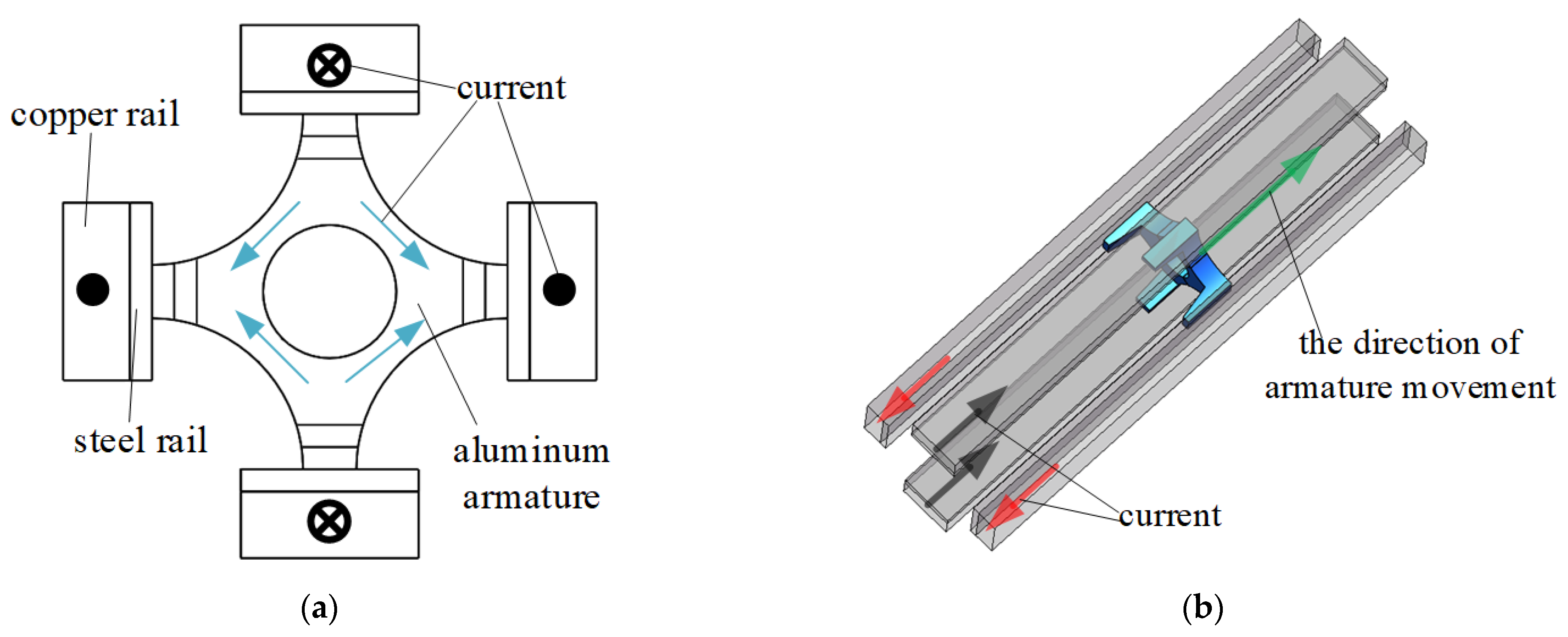

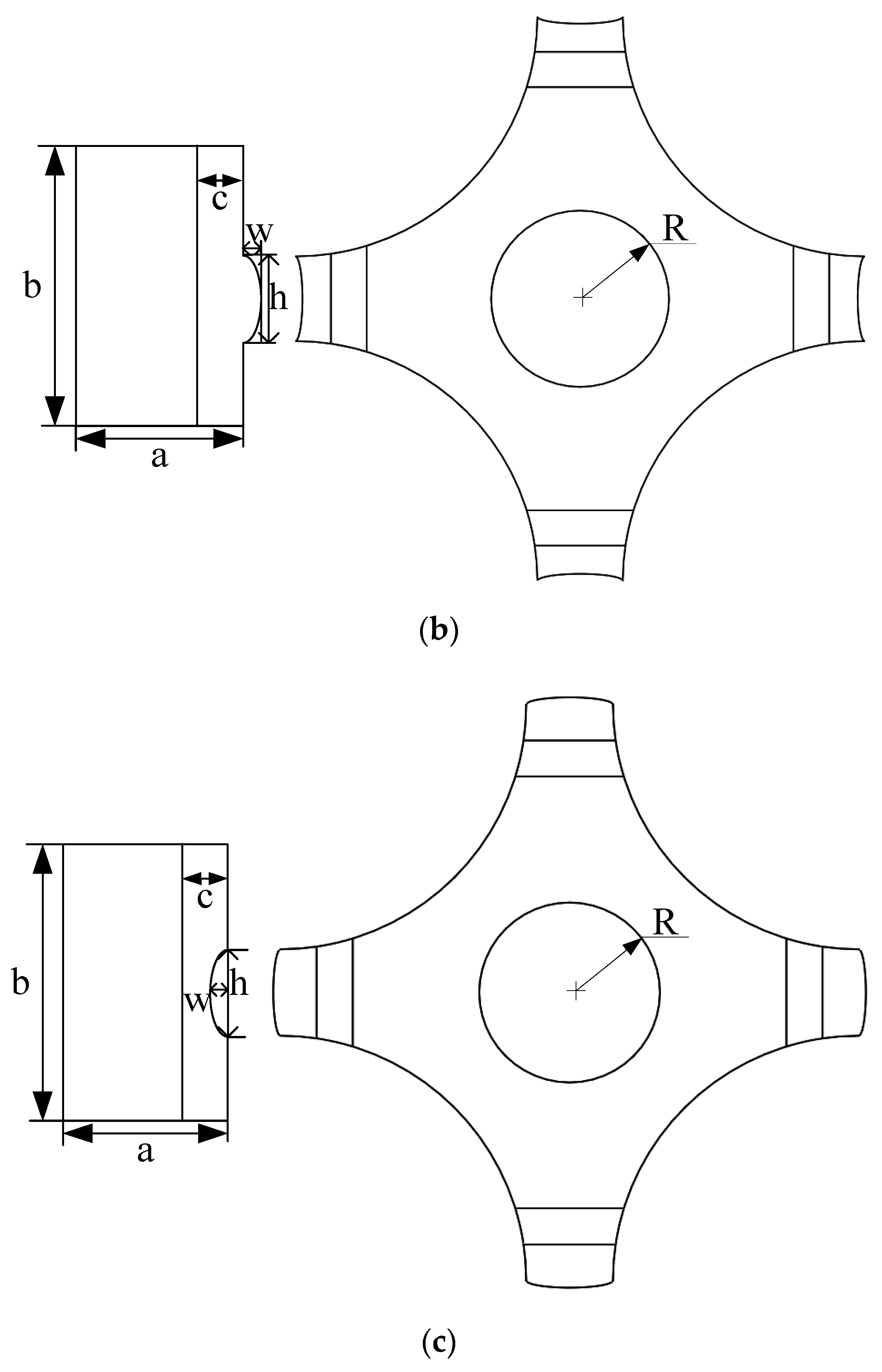
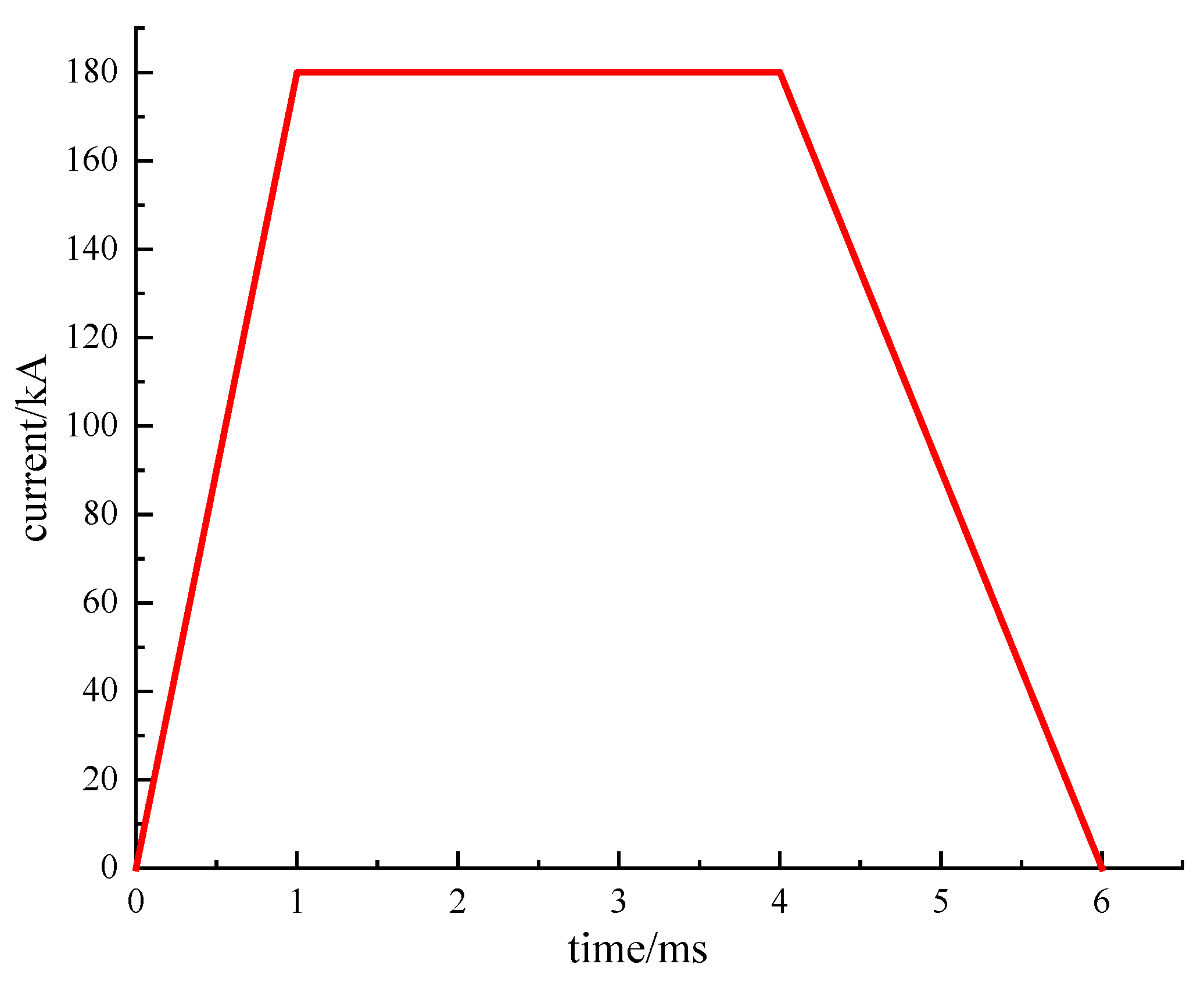


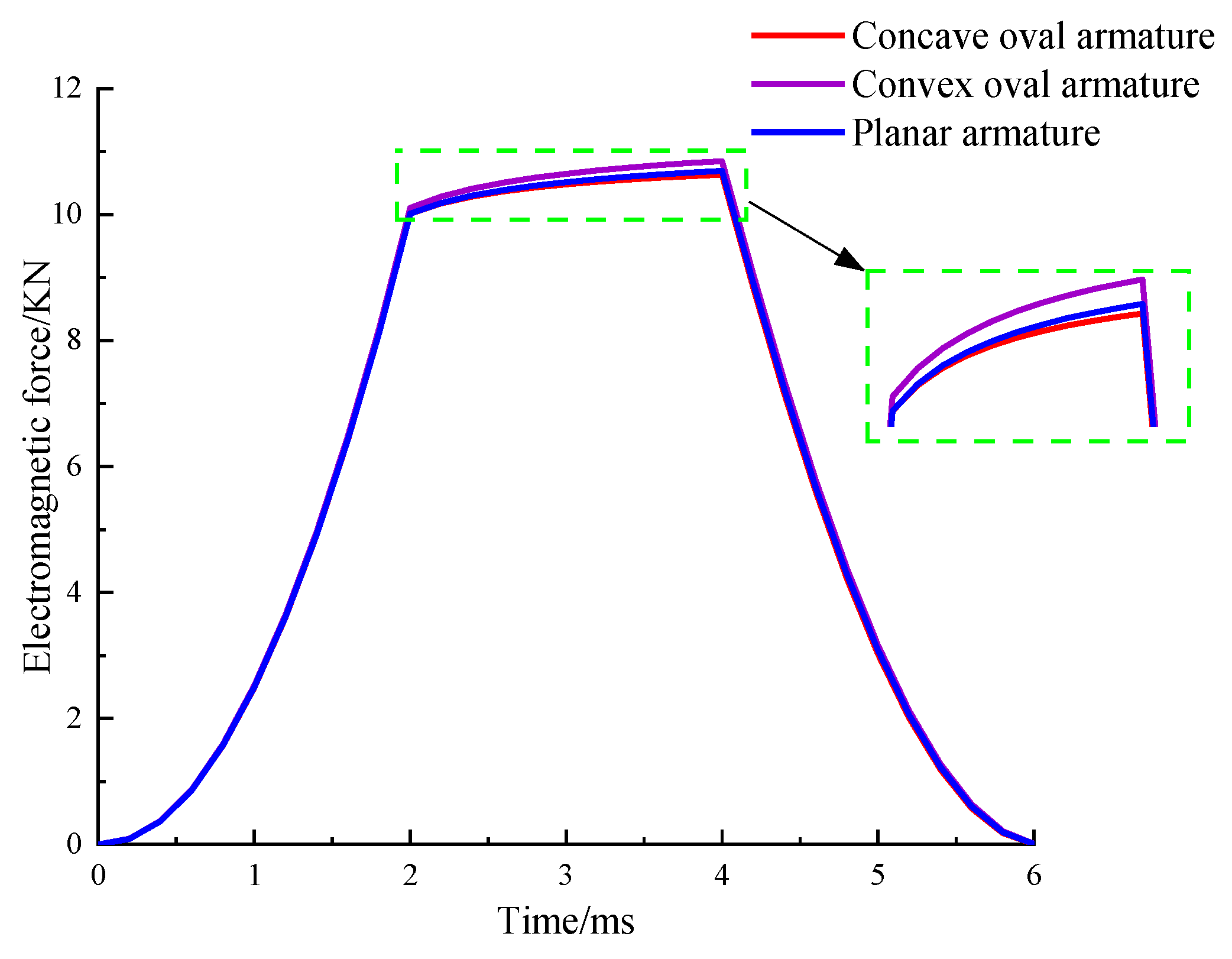
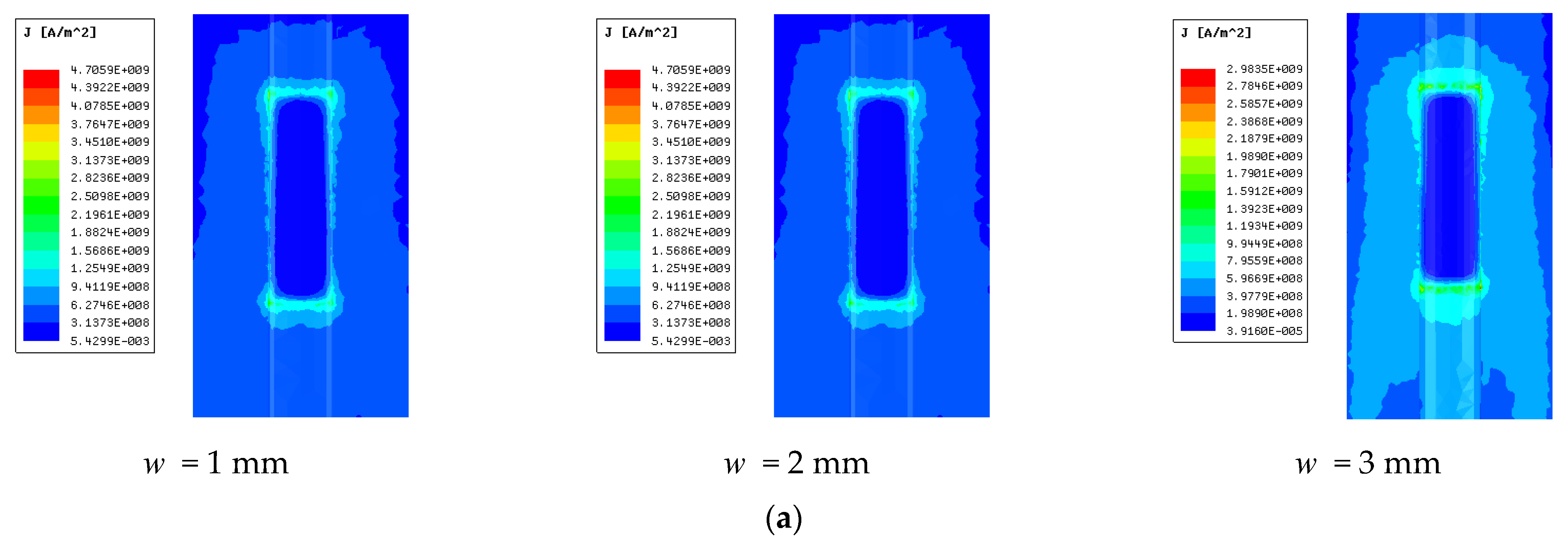

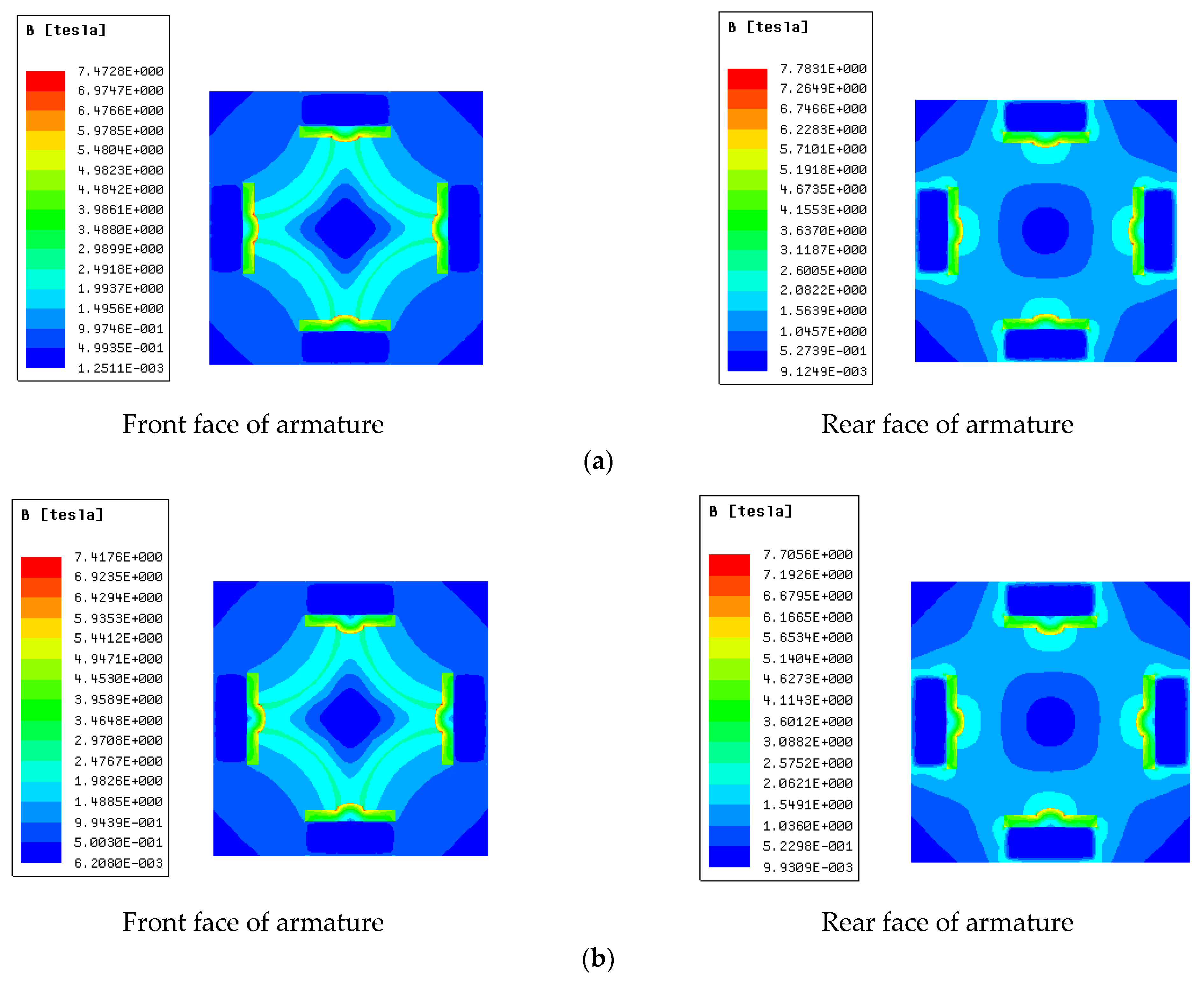

| Material | Relative Permeability/− | |||
|---|---|---|---|---|
| Copper rail | copper | |||
| Steel rail | steel | 7800 | 200 | |
| Armature | aluminum |
| Parameters | ||||||
|---|---|---|---|---|---|---|
| Value/mm |
| Armature | ||||
|---|---|---|---|---|
| Convex elliptical type | 0.016 | 0.024 | 10.85 | 10.85 |
| Planar type | 0.146 | 0.081 | 10.69 | 10.69 |
| Concave oval type | 0.023 | 0.036 | 10.63 | 10.63 |
| Armature | Concave Oval Type | Convex Elliptical Type | Planar Type | ||||
|---|---|---|---|---|---|---|---|
| Concave (Convex) Value/mm | 1 | 2 | 3 | 1 | 2 | 3 | 0 |
| 23.14 | 19.28 | 16.35 | 8.18 | 6.90 | 5.17 | 3.62 | |
| Maximum Electromagnetic Thrust/KN | |||
|---|---|---|---|
| Concave Elliptical Type Armature | Convex Elliptical Type Armature | Planar Type Armature | |
| 1 | 10.63 | 10.85 | 10.69 |
| 2 | 10.37 | 10.96 | |
| 3 | 9.93 | 11.06 | |
Publisher’s Note: MDPI stays neutral with regard to jurisdictional claims in published maps and institutional affiliations. |
© 2022 by the authors. Licensee MDPI, Basel, Switzerland. This article is an open access article distributed under the terms and conditions of the Creative Commons Attribution (CC BY) license (https://creativecommons.org/licenses/by/4.0/).
Share and Cite
Zhang, P.; Shu, T.; Li, T. Electromagnetic Characteristics Analysis of Quadrupole Compound Orbital Electromagnetic Launcher with Different Configurations. Electronics 2022, 11, 2650. https://doi.org/10.3390/electronics11172650
Zhang P, Shu T, Li T. Electromagnetic Characteristics Analysis of Quadrupole Compound Orbital Electromagnetic Launcher with Different Configurations. Electronics. 2022; 11(17):2650. https://doi.org/10.3390/electronics11172650
Chicago/Turabian StyleZhang, Pengxiang, Tao Shu, and Tengda Li. 2022. "Electromagnetic Characteristics Analysis of Quadrupole Compound Orbital Electromagnetic Launcher with Different Configurations" Electronics 11, no. 17: 2650. https://doi.org/10.3390/electronics11172650





